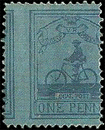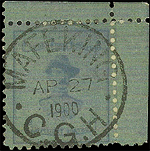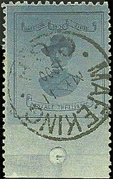
It is many years since a good offering of Mafeking has appeared on the market in the U.K. but recently
 Spink's of London sold the Anglo-Boer War collection of the late Harry Birkhead from
South Africa. Out of the 427 lots in the auction, the Mafeking part consisted of 82 items.
Some prices went way above what was considered the market price, despite the buyers
premium amounting to 29% for European Union members. The buyer's premium was 20%
plus VAT of 4% and as the collection came out of the EU, an extras 5% was charged. One
item that went way above the estimate was the mint 1d Goodyear cyclist dramatically
misperforated which was estimated at £250-£300 but sold for £1700 (€2000 US$2720), but
if the buyer had waited for the April auction of Tony Lester, based in the West Midlands, a
similar stamp sold for £460 (€540, US$735) plus Buyers premium.
Spink's of London sold the Anglo-Boer War collection of the late Harry Birkhead from
South Africa. Out of the 427 lots in the auction, the Mafeking part consisted of 82 items.
Some prices went way above what was considered the market price, despite the buyers
premium amounting to 29% for European Union members. The buyer's premium was 20%
plus VAT of 4% and as the collection came out of the EU, an extras 5% was charged. One
item that went way above the estimate was the mint 1d Goodyear cyclist dramatically
misperforated which was estimated at £250-£300 but sold for £1700 (€2000 US$2720), but
if the buyer had waited for the April auction of Tony Lester, based in the West Midlands, a
similar stamp sold for £460 (€540, US$735) plus Buyers premium.
Probably the "holy grail" of Scout collecting is the 3d Baden-Powell Reversed Head stamp. One sheet of
 twelve stamps was printed showing B-P facing to the right, which was caused when
twelve stamps was printed showing B-P facing to the right, which was caused when
 the glass negative was placed the wrong way round for
printing. Ten copies are still known to exist, with a mint and
used copy in the Royal Collection. I know that four of these
stamps are in collections of SGSC members (alas not in
mine!) but I consider the corner copy sold is the finest of those recorded. It sold for £34,000 (€40,100 US$ 54,400) and
if the buyer came from the EU he would have had to pay a
staggering £43,860 (€51745 US$ 70,175). Five used Large
Head cracked plates sold between £1200 and £2700, but the
most exceptional sale was for the B-P Large Head imperforate at the bottom and
estimated at £1500-2000, made £7000 (US$11,200 €8250). This previously sold for
£1800 at Argyll Etkin Auction in October 2001. The auctioneer's catalogue stated that the circular mark below
the postmark of this stamp was a "screw hole" but I am convinced that this was a drawing pin. Our older U.K.
members will recall that up until at least the 1950's drawing pins were produced by having the pin pressed out
of the circular metal. When the stamps were originally produced, twelve prints were fixed to a board and then
re-photographed to produce a glass negative for the sheet of twelve stamps.
the glass negative was placed the wrong way round for
printing. Ten copies are still known to exist, with a mint and
used copy in the Royal Collection. I know that four of these
stamps are in collections of SGSC members (alas not in
mine!) but I consider the corner copy sold is the finest of those recorded. It sold for £34,000 (€40,100 US$ 54,400) and
if the buyer came from the EU he would have had to pay a
staggering £43,860 (€51745 US$ 70,175). Five used Large
Head cracked plates sold between £1200 and £2700, but the
most exceptional sale was for the B-P Large Head imperforate at the bottom and
estimated at £1500-2000, made £7000 (US$11,200 €8250). This previously sold for
£1800 at Argyll Etkin Auction in October 2001. The auctioneer's catalogue stated that the circular mark below
the postmark of this stamp was a "screw hole" but I am convinced that this was a drawing pin. Our older U.K.
members will recall that up until at least the 1950's drawing pins were produced by having the pin pressed out
of the circular metal. When the stamps were originally produced, twelve prints were fixed to a board and then
re-photographed to produce a glass negative for the sheet of twelve stamps.
|



